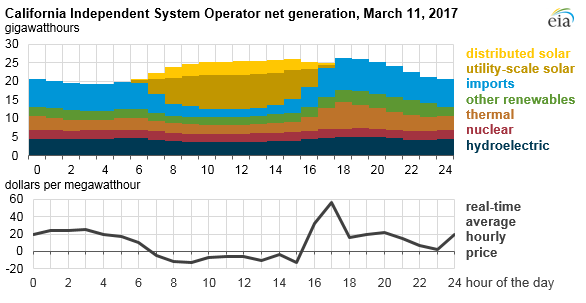|
I have written several posts on the theme of the limits of the percentage of electricity generation that can be supplied with intermittent sources. I have focused on this topic because until actual limits are reached and accepted, there is no incentive to examine other alternatives like StratoSolar.
This article on the Energy Collective discusses the latest data from California and its infamous “Duck Curve”. In 2016 California increased its installed PV capacity by 50%, bringing its total to 14.6GW, 5.4GW of which is rooftop, and 9.2GW is utility scale systems. This level of deployment was not expected until the early 2020s and makes California a significant test case for the limits to intermittent generation. As the article describes, limits to the generation that can be consumed are starting to appear, though the percentage of electricity from Solar is still only around 12%. Solar is seasonal with low generation in winter and high generation in summer. Demand is also seasonal but does not match the seasonal supply. There is now an excess of supply over demand around March, April and May as the days lengthen but the demand from air conditioning is still low. The EIA graph above shows the situation for a day in March. The key detail is that prices were negative for a significant part of the day. That means that thermal, nuclear and hydroelectric found it more economic to pay to generate electricity rather than stop generating electricity. This is an early indication of the difficulty that other sources of electricity generation have in adapting to solar in large amounts. At present this only happens in spring, but at the rate that solar is growing in California, negative pricing is going to grow rapidly. The theoretical limit for solar in California is probably between 30 GW and 40 GW, but the ramp to there from today's 14 GW will be painful for grid operators and at current rates of PV installs will only take a few years. CAISO publishes lots of data. Among this is a daily real time solar dispatch curtailment report. This shows the solar energy that must be curtailed, in other words thrown away. This is small today but will grow significantly and rapidly as more solar is added. Early indications are that there is a limit to how much existing thermal and other generators can ramp up and down. They also must sustain the added costs of lost generation capacity factor. This is a real economic issue and there is going to have to be a lot of politics aimed at maintaining the economic viability of fossil fuel generation which is essential for when the sun does not shine. Curtailment will also reduce the capacity factor of PV and thus increase its cost of generation. Because sun and wind can disappear for weeks, backup generation will always be necessary. Storage will not solve this long-term intermittency problem. This is a truth that is ignored, much like the curtailment and negative pricing issues have been ignored. California is pushing hard for deployment of storage technology as an answer. The unfortunate reality is there is no deployable storage technology today, a storage technology that could be deployed in the tens of GW that are needed is far in the future and storage won’t solve long term intermittency. Because of the rapid rate of PV deployment, California is having to address these problems sooner than anticipated. The potential good news is that facing reality may finally address the wishful thinking that has prevailed to date and open minds to new solutions that can solve these problems. By Edmund Kelly
Comments
|
Archives
December 2023
Categories
All
|
|
© 2024 StratoSolar Inc. All rights reserved.
|
Contact Us
|


 RSS Feed
RSS Feed